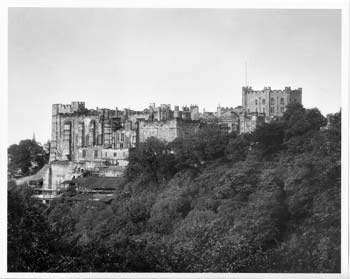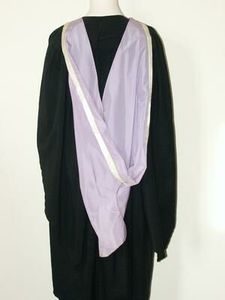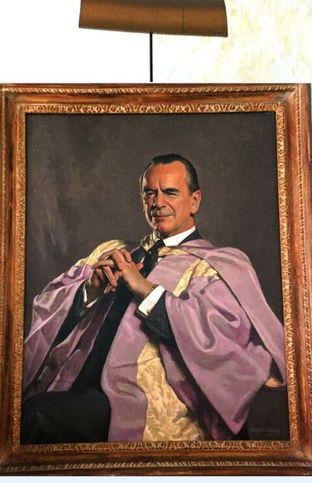This castle, older than both Oxford and Cambridge Universities by a century-and-a-half, was given to the University he founded (1832 ) by Bishop van Mildert. His aim was to ensure a steady supply of graduate parsons and schoolmasters in the North of England, where remoteness and cold winters made it hard to recruit men from the easier South. Durham, modelled on the older Universities, was highly successful in achieving this and continued with the aim of meeting wider educational needs in the North.
Musical performance of all kinds has always been important in Northern life. A small army of professional teachers and performers was supplemented by a much larger one of gifted amateurs who earned their living in often hum-drum occupations. Despite obstacles, many had acquired diplomas but there was no realsitic way for most to proceed to degrees. Even the few who had the leisure for full-time study lacked the Classical education and the financial resources required by Oxford and Cambridge.
Durham's Senate produced a remedy. The University would institute the degrees of Bachelor and Doctor of Music, available to non-resident students. Harmony, Counterpoint, Music Theory, History and other relevant subjects would be examined and every candidate would have to offer an extended composition - in four parts for the lower degree and in eight parts for the Doctorate.
Musical performance of all kinds has always been important in Northern life. A small army of professional teachers and performers was supplemented by a much larger one of gifted amateurs who earned their living in often hum-drum occupations. Despite obstacles, many had acquired diplomas but there was no realsitic way for most to proceed to degrees. Even the few who had the leisure for full-time study lacked the Classical education and the financial resources required by Oxford and Cambridge.
Durham's Senate produced a remedy. The University would institute the degrees of Bachelor and Doctor of Music, available to non-resident students. Harmony, Counterpoint, Music Theory, History and other relevant subjects would be examined and every candidate would have to offer an extended composition - in four parts for the lower degree and in eight parts for the Doctorate.
|
Among the first graduates (1891) was Hilary Davan Whetton, whose descendant is a distinguished modern conductor. In 1894, the list included Edward Bairstow and in 1896 Walter Alcock; their names are well-known to lovers of church music (and Alcock's to railway enthusiasts!). The first Doctorates were granted in 1897 (with Bairstow and Alcock following not long after). The first women graduates (1900) were Louisa Archer, Blanche Master and Annie Mixer.
|
|
In 1910, Janet Salsbury became the first woman to receive the DMus degree. By this time, the Durham BMus hood (pic. 2) had become a familiar sight in organ lofts and at academic assemblies. Many of those who obtained the qualification remained on native heath, some with music a hobby rather than a means of earning a living. Those who became teachers often showed a missionary zeal in encouraging promising pupils to prepare for a Durham degree. Others entered the wider world of professional music, many with great distinction. The list of recipients of the 875 music degrees awarded includes numerous cathedral organists, conductors and administrators.
|
Most widely known was Dr - later Sir - Malcolm Sargent, who was one of the last to be trained by the traditional means of apprenticeship to a cathedral organist. For 40 years he was regarded as the outstanding British conductor, especially of choral music. His 1946 recording with the Huddersfield Choral Society of Messiah (on a dozen or so 12" 78rpm discs) sold more than 400,000 copies in the USA alone. His portrait (pic. 3) shows him wearing the robes of a Durham DMus. These are a brocaded white satin robe with sleeves and facings of palatinate (purple) silk and a brocaded white satin hood, lined with palatinate.
The number of candidates for the degrees declined steadily in post-war years. Generous grants made it much easier for students to enrol at any of the increasing number of institutions offering full time resident courses. The introduction of an intermediate MMus qualification from 1960 did little to arrest decline; the last Durham music degree was awarded in 1994.
The question has been asked: Will it remain the last? In recent years, full-time study at university has become enormously expensive with many students starting their working lives saddled with debts equivalent to several years' earnings. Music has never been a highly paid profession and interest in returning to the older system may revive. Let's hope so.
The number of candidates for the degrees declined steadily in post-war years. Generous grants made it much easier for students to enrol at any of the increasing number of institutions offering full time resident courses. The introduction of an intermediate MMus qualification from 1960 did little to arrest decline; the last Durham music degree was awarded in 1994.
The question has been asked: Will it remain the last? In recent years, full-time study at university has become enormously expensive with many students starting their working lives saddled with debts equivalent to several years' earnings. Music has never been a highly paid profession and interest in returning to the older system may revive. Let's hope so.
David Bridgeman-Sutton,
December 2011
December 2011
Footnote: Bishop van Mildert has been praised for generosity in giving Durham castle to the university he founded. Cynics point out that it was in fact church, not personal, property. Also that some years after the gift was made, the curtain wall seen in picture 1 and adjacent buildings were found to be sliding down the bank to the river. The immensely expensive civil engineering project involved in correction was, of course, funded by the University. The building is to-day University College: a model of the remedial work to the wall is on display within.
Acknowledgements:
Picture 1 : Reproduced by permission of English heritage: NMR.
Picture 2: Reproduced by permission of Dr Thorsten Hauler www.burgon.org.uk/
Picture 3: Reproduced by permission of Miss Sylvia Darley OBE
Picture 1 : Reproduced by permission of English heritage: NMR.
Picture 2: Reproduced by permission of Dr Thorsten Hauler www.burgon.org.uk/
Picture 3: Reproduced by permission of Miss Sylvia Darley OBE




